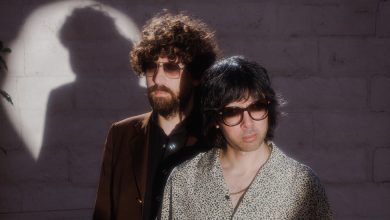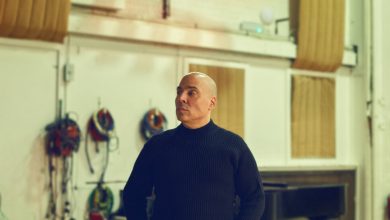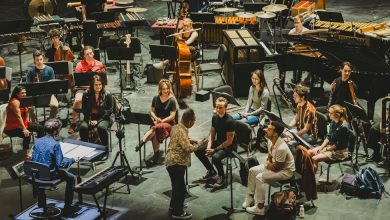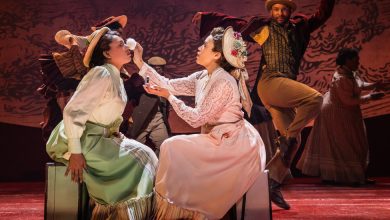‘Being a Woman is Full of Horror’: Female Directors Discuss Their Craft

LONDON — When Ruth Paxton was 14, her father sneaked her into a movie theater in Scotland to see an anniversary rerelease of “The Exorcist,” the classic 1973 film about a possessed girl.
“He was really excited about us watching it,” Paxton said recently, pointing out that the film had once been banned from home video release in Britain. “But when we came out, I was, like, ‘That was rubbish!’”
It probably didn’t feature enough blood for her taste, she added, laughing.
Now, Paxton, 38, is trying to unsettle audiences with her own story of possession. Her debut feature, “A Banquet,” about a girl who refuses to eat, comes to U.S. theaters and on-demand services on Friday. Writing in The New York Times, Lena Wilson praised the film’s “slow-burn magic” and made it a Critic’s Pick.
“A Banquet” is the latest in a string of acclaimed recent horror movies from Britain and Ireland made by first-time female directors. It follows Rose Glass’s 2021 film “Saint Maud” and Romola Garai’s “Amulet,” from 2020, as well as Prano Bailey-Bond’s “Censor,” the tale of a strict film classification official who ends up in an on-set blood bath.
More are on the way, including Kate Dolan’s “You Are Not My Mother,” out March 25, about a young girl in Ireland whose mother starts acting strangely, and Charlotte Colbert’s “She Will,” in which a woman travels to Scotland to recover from a double mastectomy and ends up channeling the spirits of local witches.
Alan Jones, a co-founder of FrightFest, the Britain’s most prominent horror movie festival, said that female directors have been working in the genre since its inception, but in the last five years, their numbers in Britain and Ireland have swelled. They were bringing “a female perspective to the clichés of old,” Jones said.
One reason for the boom was that horror was more open to debut female directors than other genres, he said. “You don’t need stars, or even that much money,” Jones said. “You just need a really good idea.”
Last week, four of those debut filmmakers, all aged in their 30s — Paxton, Bailey-Bond, Dolan and Colbert — gathered on a video call to discuss what attracted them to the genre, what they bring to it as women and how horror films can bring about social change.
These are edited extracts from their conversation.
This isn’t the first wave of female horror directors. Why do you think another one is rising up now, in Britain and Ireland?
PRANO BAILEY-BOND It’s not just women who are making a lot of horror here: We’ve got Rob Savage and Remi Weekes and Mark Jenkin. But the conversations around diversity in the industry are now allowing all the women who have wanted to be making horror for years and years to make films at last.
KATE DOLAN All the female directors that I admired growing up, like Kathryn Bigelow and Claire Denis and Mary Harron, almost all of them made at least one horror movie. It’s not necessarily that women are just now being drawn to horror; they’re just getting a chance.
In the 1980s, Britain had a list of horror films — the so-called “video nasties” — that were effectively banned for home viewing, as shown in “Censor.” Some horror fans talk about working their way through that list as a way into the genre. What was your route in?
DOLAN When I was growing up, I watched loads of horror and I think it was really exciting for me then, because it’s a genre where there’s female protagonists who survive and win — “the final girl.” As a teenage girl that was really empowering.
BAILEY-BOND I, similarly, was totally attracted to the genre, to extreme things going on in films. I think at first it was partly the physical thrill — the knowledge that when you finish watching, you then have to go upstairs to bed, and you think something’s going to grab your ankles.
But I never thought about being a horror director until someone saw my show reel and said I was one. I remember getting off that call going, “Am I?” But if people want to pigeonhole you, sometimes that can be useful, because there’s a lot of filmmakers out there, so how do you make yourself stand out?
CHARLOTTE COLBERT I love how there’s a great artistic freedom in horror that’s perhaps not available in other genres. Obviously, in a drama, you can’t have a worm growing out of someone’s nostril, or something else so bold or artistic. But horror has really incredible freedom in terms of visuals and characters, and what’s acceptable and believable.
PAXTON Growing up, I watched lots of horror, but mainly because they had lots of soft porn in them, and I wanted to see the sex!
But I think I’ve always liked to look in the dark corners of things, and that’s in part because of my own experience. The scariest experiences I’ve ever had have been in my own head.
Even if the boom in Britain is across all genders, what do you feel women, specifically, are bringing to horror?
Five Movies to Watch This Winter
1. “The Power of the Dog”: Benedict Cumberbatch is earning high praise for his performance in Jane Campion’s new psychodrama. Here’s what it took for the actor to become a seething alpha-male cowboy.
2. “Don’t Look Up” : Meryl Streep plays a self-centered scoundrel in Adam McKay’s apocalyptic satire. She turned to the “Real Housewives” franchise for inspiration.
3. “King Richard”: Aunjanue Ellis, who plays Venus and Serena Williams’s mother in the biopic, shares how she turned the supporting role into a talker.
4. “Tick, Tick … Boom!”: Lin-Manuel Miranda’s directorial debut is an adaptation of a show by Jonathan Larson, creator of “Rent.” This guide can help you unpack its many layers.
5. “The Tragedy of Macbeth”: Several upcoming movies are in black and white, including Joel Coen’s new spin on Shakespeare’s “Macbeth.”
PAXTON With “A Banquet,” my route into it was my experiences of disordered eating, and then the ripple effect of that on the family around me, and particularly the dynamic with my mum, who wanted me to eat when I wouldn’t.
I really don’t know what I bring, except my own interests. I’ve been freakishly death aware since I was a kid — I wrote a last will and testament when I was eight years old — but I don’t know if that has anything to do with my sex.
DOLAN You can only bring your own life experience to what you create. Being a woman is full of horror, so bringing those experiences to horror makes sense.
My next project is hopefully about the bodily autonomy of women in Ireland, as we’ve had a terrible fight for reproductive rights here. I want to make films about my experiences and struggles.
Is horror a better than other genres for exploring those issues?
COLBERT Personally, I think it’s an amazing and creative way to address social issues. And what’s also cool is that generally teenage boys are the biggest audience, so it’s a fantastic way to convey feminist imagery to people who aren’t necessarily interested. It could really have a long-term impact on the next generation.
DOLAN It’s interesting you say that, as there’s a great book called “Men, Women and Chainsaws” by a scholar, Carol J. Clover, and she has a section where she talks about slasher movies and how they turn the male audience into “the final girl,” essentially. So the audience have to perceive her fear of being chased by the killer, which makes them relate to the female character more.
We’re also seeing a wave of acclaimed horror movies worldwide, including Jordan Peele’s films from the United States; the French director Julia Ducournau won the top prize at last year’s Cannes Film Festival with “Titane.” Does anything make British and Irish horror different?
BAILEY-BOND Britain’s really good at folk horror — “The Wicker Man,” of course. I don’t necessarily think that’s where we need to stay, but there seems to be something in our culture and our history that serves that subgenre. And it kind of feels like it belongs to this land a little bit.
The same goes for the Gothic haunted house story. We’re very good at that, and if you think of Britain and its architecture, a big spooky house with a maid really fits.
COLBERT Yes, somehow the landscapes here, especially in Scotland, the mist, feel so anchored with tales and mythology. Even in England, sometimes I feel you could film any landscape and the creatures of the past will pop out.
BAILEY-BOND That makes me think of the trope in American horror of films like “Poltergeist” exploring legacies with Native American burial sites. It’s that same relationship to your past and either the fears of that land, or the guilt of that land, and how the land holds memory. With horror, you can tap into all of that.



